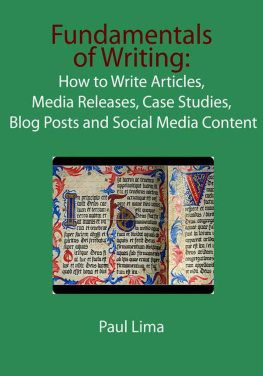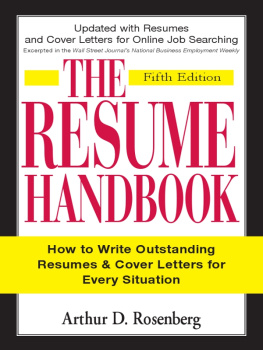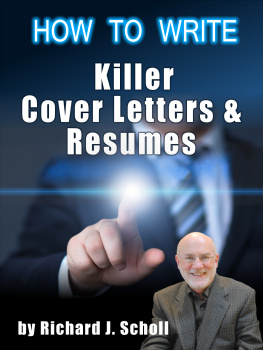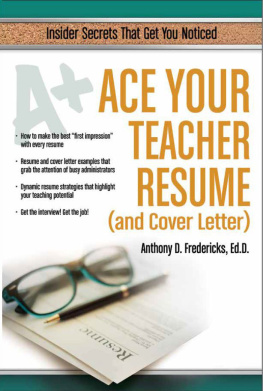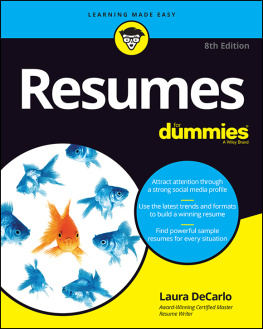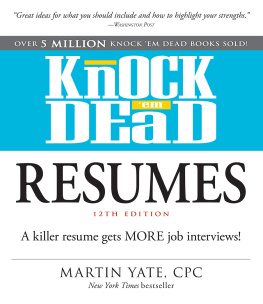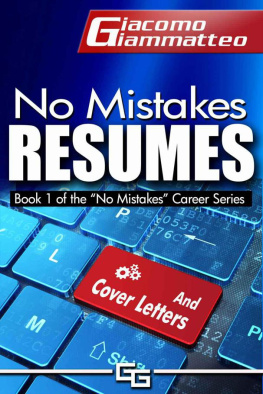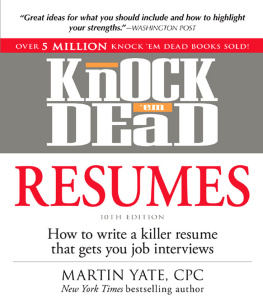How to Write Winning Resumes and Cover Letters and Ace Job Interviews: Write Customized Resumes and Cover Letters That Will Open Doors to Job Interviews
Paul Lima
H ow to Write Winning Resumes and Cover Letters and Ace Job Interviews
Cover and interior design: Paul Lima
Published by Paul Lima, Toronto, Ontario, Canada www.paullima.com/books
All rights reserved. No part of this publication may be reproduced, stored in or introduced into a retrieval system or transmitted in any form or by any means (electronic, mechanical, photocopying, recording or otherwise), without the prior written permission of the copyright owner.
First Edition copyright 2019 by Paul Lima.
How to Write Winning Resumes and Cover Letters and Ace Job Interviews / Paul Lima1st edition.
ISBN 978-1-927710-34-0
W elcome to How to Write Winning Resumes , a book written for people who are job hunting and need a winning resume to open the door to job interviews. This book will help you improve your resume writing skills and in the process it will help you strengthen your business-writing abilities as well. However, the focus of the book is on how to write resumes and cover letters that sell your strengths and abilities related to the job that you are seeking, and how to ace job interviews.
The writing premise of this book is based on a business-writing course that I teach for University of Toronto continuing education students and for private clients. In addition, I was a career counselor for almost a decade, helping graduates apply for jobs. A great deal of my work included conducting resume writing workshops as well as editing resumes.
This book is not for you if you want to learn how to write a resume and then never revise it for the various jobs you apply for. We will talk about producing a solid resume, and the importance of revising it, or customizing it, for each job you apply for. In other words, this book is all about effectively communicating who you are in relation to your background and experience and the different jobs you apply for.
With a winning resume and cover letter, you want to conveying your experience in relation to the job you are seeking. And you want to do this in a concise and focused manner so your readers understand why you are writing, why you are qualified and what action you need them to takewhich is usually to call you (text or email you) to set up interviews.
When it comes to resume writing, How to Write Winning Resumes will get you grounded and focusedespecially if you often feel like you're spinning your wheels when you write about yourself. Then it will help you effectively write well-structured, focused resumes and cover letters that communicate your experience, strengths and abilities in a clear, concise manner. Finally, it will help you prepare to ace job interviews.
To get started, you will be introduced to the business-writing process, a process that you apply to your resume, as well as to any writing that you do. As an important part of the process, you will get as organized as possible before you writeas this book will show you how to do.
Note : This is the first edition of the book. It should be 99.5% error-free. If you like to play "spot the typo," feel free to let me know if you find any errors, or have any other comments about the book. Email . American spelling has been used. All attempts have been made to correct any format errors; however, a few may exist.
Paul Lima
www.paullima.com
Chapter 2: Communication Process
I am going to show you sample resumes and cover letters in this book. Some readers might expect to see them upfront, as in: "Here are sample resumes and cover letters. Go forth and write your resumes and cover letters like these samples."
However, the book is not going to unfold in that way. You would not look at a sample sales letter or report and then go forth and write one. Yes, you need to see the format your writing should follow, but before you begin to write, you need to research your content. You also need to understand the communication and the writing processes. But first, to get you started, allow me to tell you a bit about the resume.
There are two basic types of resumes: chronological resume, also called the reverse chronological resume, and the functional resume. It's your job to figure out which type will work best for you, based on your education and work experience and the type of job that you are seeking.
You might ask why so much time is spent creating your resume. The answer is simple. When they are done right, resumes work. An effective resume is a sales pitch to a prospective employer. You are the salesman, selling your experience, skills, abilities and education. A well-written resume is one of your best marketing tools. Its a promotion that sells you, and you want the hiring manager to buy you.
In short, when it comes to resumes and cover letters, you are the content you want to write about. So I am going to show you how to research yourself so that you can produce clear, focused, comprehensive documents. But before I do that, I am going to tell you a bit about the communication and writing processes.
Once you understand those processes and conduct research into you, I will show you how to apply all that you have learned to the writing of resumes and cover lettersjust as I show people in all my other books on various types of writing how to apply the processes and their research to the documents they want to produce.
Communication Process
T o begin, let us look at the communication process.
Communication is a process. If you want to communicate effectivelyin writing or when speakingyou should understand the process. Communication requires a sender who sends a message through a channel to a receiver. The process is not complete, however, without feedback; feedback closes the communication loop. Sometimes, noise (competing messages, distractions, misunderstandings) interferes with your message; feedback lets you know if the receiver has received and understood your message.
When you communicate in person, you can ask for feedback, ask people if they understand what you are saying or have any questions. However, when you communicate in writing or through other one-way media (such as broadcast), it is more difficult to ask for feedback. Advertisers have learned how to use direct-response marketing techniques such as discount coupons, time-limited offers and so on to motivate and measure feedback. You don't have those tools at hand when looking for a job. In fact, you do not close the communication loop in your resume. You close it in your cover letter.


